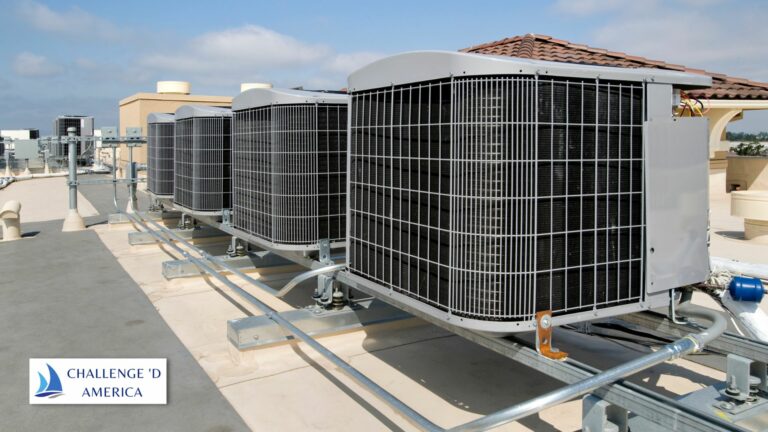How Do You Properly Store And Maintain A Sailboat During The Off-Season?
As a sailing enthusiast, I know how important it is to properly store and maintain a sailboat during the off-season. It’s essential to preserving the integrity of the vessel and ensuring its longevity.
With the right steps, you can enjoy your sailboat for many seasons to come. In this article, I’ll share with you my experience and expertise on storing and maintaining your sailboat during the off-season, so you can keep your vessel in tip-top shape.
From choosing the right location and taking the right steps of maintenance to understanding the importance of shrink-wrapping and winterizing the engine, I’ll cover everything you need to know to ensure your sailboat is ready to go when it’s time to hit the water again.
Preparing The Sailboat For Off-Season Storage
One of the most important steps to properly maintaining a sailboat during the off-season is to properly prepare it for storage. This will ensure that the boat is in good condition when you are ready to set sail again at the start of the next season.
The following steps will help you prepare your sailboat for off-season storage:
- Clean and dry the hull, deck, and interior. This can be done by wiping down the surfaces with fresh water and then drying them with a soft cloth. You may also want to treat the surfaces with a mild detergent or wax to help protect them from the elements.
- Check for damage and repair as necessary. This includes inspecting the hull for cracks and other damage, such as weak seams or blisters. If any damage is found, the boat should be repaired before the boat is put into storage.
- Disassemble the rigging. The sails and rigging should be removed and stored in a safe, dry area. Be sure to check all lines and hardware for fraying and wear and replace as necessary.
- Apply oil and grease as necessary. All exposed metal parts should be oiled or greased, and all moving parts should be lubricated.
- Check the electrical wiring. Inspect the wiring and connections in the boat and ensure that they are in good condition.
- Drain the plumbing. All water tanks and pumps should be emptied and the lines should be drained.
- Store the boat in a secure location. The boat should be stored in a secure location away from high winds, direct sunlight, or extreme temperatures. An indoor storage facility or a covered parking space is ideal.
Following these steps will help you properly prepare your sailboat for off-season storage and ensure that it is in perfect condition when you are ready to set sail again.
A. Cleaning The Sailboat
Cleaning the sailboat during the off-season is essential to ensure the boat is stored in top condition. We recommend starting with the deck, as dirt and grime can accumulate quickly and begin to damage the boat.
Start by hosing down the deck and removing any visible dirt and grime with a soft scrub brush. To prevent staining, use a pressure washer on a low setting and avoid getting too close to the gelcoat.
Next, remove any sails, canvas and covers, and rinse them off with clear, freshwater. Allow them to air dry before folding them and storing them away.
If the boat has a teak deck, use a teak cleaner and scrubber to clean and brighten the teak. If the boat has other types of decking, use a mild detergent or cleaner to remove dirt and grime.
Finally, rinse off the hull with a hose, paying special attention to the waterline. Using a soft sponge, gently wash the hull with a mild detergent or cleaner. Rinse the hull thoroughly and use a chamois or microfiber cloth to dry the hull.
For extra protection, you can apply a coat of wax to the hull before storing the boat away. This will help the paint last longer and keep the boat looking its best.
Now your sailboat is clean and ready to be stored away until the next sailing season.
B. Inspecting The Sailboat
Before putting a sailboat into storage, it is essential to inspect it thoroughly to ensure that it is ready for the off-season. This should include an inspection of the rigging, hull, sails, and deck.
Starting at the top, inspect the mast and all of the standing rigging. Check to make sure that all turnbuckles are properly tensioned and that any frayed lines or corrosion is properly repaired.
Look for any signs of wear or damage on the sails, especially the luff, leech, and clew. Any damages should be repaired before storing the sailboat.
Inspect the hull for any signs of damage. Look for cracks, blisters, and any water that has been trapped in the hull. Make sure the rudder is securely attached and that the rudder stock is not worn.
Check the keel for any damage, especially if it is a swing keel. Check for any loose screws, missing hardware, and signs of wear on the deck and any hatches and portlights.
Finally, check the engine and drive train for any signs of wear and tear. Make sure the engine is properly lubricated and that all filters and hoses are in good condition. Check the fuel tank for any water or debris and make sure the fuel is still good before storage.
By thoroughly inspecting the sailboat before storage, sailors can ensure that their vessel is in good shape and ready to go when the sailing season starts again.
C. Securing The Sailboat
When the sailboat is put away for the off-season it is imperative to secure it in order to protect it from the elements. Depending on the type of boat, anchoring, dry docking, or storing on land are all suitable options that can be implemented to maintain the boat while it is not in use.
Anchoring the sailboat in a sheltered location is the most common method when the boat is stored in water. This can be done by either utilizing a permanent or temporary mooring, and adding additional lines if needed for extra security.
The boat should be anchored with the bow into the wind and in a position that is easy to access by water.
For dry docking, a marina could be used, or in some cases, a floating dock. This position allows for easy access to the boat, even in bad weather. The sailboat should be secured and supported by several lines and cushioned with fenders.
To ensure the boat remains in place and minimizes the risk of damage, it is important to securely tie the boat to the docks or other support structures with lines of appropriate strength.
Storing a sailboat on land also offers protection from the elements and can be done by either trailering or standing the boat on its hull. When selecting a location to store the boat on land, select a level, well-drained area that is free of debris and other objects that can potentially cause damage.
The boat should be propped up by supports and secured to them by ratchet straps or other lines of appropriate strength. It is also important to cover the boat with a suitable protective cover to further protect it from the elements.
Regardless of the storage method chosen, it is essential to check the sailboat regularly for any damage or signs of wear and tear. This should be done to ensure the boat remains in good condition and is ready for use when the sailing season returns.
D. Winterizing The Sailboat
With the onset of autumn, the time has come to winterize your sailboat. Winterizing your boat will prevent rust, corrosion and freezing temperatures from damaging the boat during the off-season.
Here are a few steps to ensure your boat is winterized properly:
- Clean and dry all parts of the boat. Be sure to dry the rigging and inspect the hull for any cracks or holes that might allow water to seep in.
- Apply an anti-fouling bottom paint to the hull to prevent barnacle or weed growth.
- Clean and lube all moving parts and make sure the rigging is properly tensioned.
- Securely stow all removable equipment such as sails, swim ladders, and anchors.
- Check all electrical and plumbing systems for any needed repairs and make sure the batteries are disconnected and stored in a warm, dry place.
- If you can, cover the boat with a heavy tarpaulin for extra protection.
- Make sure the boat is securely stored and drain the bilges of any standing water.
By properly winterizing your sailboat, you can prevent damage and ensure better performance when the sailing season begins again in the Spring.
Storing The Sailboat
Prior to storing your sailboat for the offseason, a thorough cleaning and maintenance is essential. This will help to prevent problems from arising when you come to re-launch your boat.
Start by inspecting the boat’s hull and deck for any damage, then clean the deck and hull surfaces. This will remove any dirt and salt build up, and remove any marine growth that might have formed over the season.
When washing the hull and deck, use soap and warm water, and take care not to scratch the paint or gelcoat. Once washed, inspect the hull and deck for any signs of damage, and apply any necessary repairs.
It is also important to check the rudder, keel, and any other moving parts of the boat, to ensure they are in good working order.
You should also check the rig and mast, as they are susceptible to wear and tear, and can also be damaged by wind and waves. Inspect the rigging, and replace any damaged or worn lines. Also inspect the mast, spreaders, and running rigging to make sure they are intact and secure.
Clean and inspect the sails, and apply any necessary repairs. Once the sails are clean and dry, store them in a dry, dark environment, such as a sail locker or a sail bag. Finally, clean the decks of any clutter and store any items off the boat, as this will reduce the risk of damage from condensation and mildew.
Once you have completed all the necessary cleaning and maintenance, your sailboat is ready for storage. Ensure to cover the boat with a tarp or boat cover, and secure it using the tie-down kit provided. This will help to protect the boat from the elements, and reduce the chance of damage over the offseason.
A. Choosing A Storage Facility
When considering where to store your sailboat during the off-season, the most important factor is to choose a storage facility that will protect your vessel from the elements. You’ll want to ensure that your sailboat is sheltered from strong winds, direct sunlight, and harsh weather conditions.
The best storage facilities are generally indoor or covered facilities that can offer a controlled environment and protection from the elements. If you’re unable to find an indoor storage option, look for a storage facility that provides a covered area with a secure roof and walls.
Make sure to check the facility’s reviews and inspect the area thoroughly before signing your contract.
You’ll also want to look for a facility that offers adequate ventilation and air circulation to avoid potential mould, mildew, and rusting. If you’re storing your sailboat outdoors, you’ll need to take extra measures to protect it from the elements.
Consider investing in a durable canvas or tarpaulin cover to provide additional protection from the sun and rain.
It’s also important to consider the location when choosing a storage facility. Find a place that offers easy access for launching and a safe and secure dock to dock your vessel. Ideally, it should be close to a marina or harbour so that you can easily access your sailboat at any time.
Finally, make sure to read the terms and conditions of the storage facility carefully and take out a suitable insurance policy to cover your vessel while it’s in storage. At the end of the day, the peace of mind that comes with a quality storage facility is worth the cost.
B. Preparing The Sailboat For Storage
Before storing your sailboat, it is essential to properly prepare it for the off-season.
First and foremost, give your sailboat a thorough clean inside and out. Use a mild detergent and soft cloths. This will help protect against the accumulation of mold and mildew due to the warm and humid conditions often associated with storage.
Next, remove the sails and store them in a cool, dry place. If the sails are dirty, use a soft brush to gently remove any dirt and salt deposits. Lightly oil the sailbag to protect the sails from any further damage.
Check the hull for any damage or wear, particularly the keel, rudder and propeller. Make sure to repair any damage or replace any worn parts.
If you plan to store the boat on its trailer, ensure that the trailer and tires are in good condition and that the boat is correctly secured. Alternatively, if you plan to store the boat in a marina, check that the dock lines are in good condition and fit for purpose.
Finally, before storing, it is essential to change the engine oil, filter and coolant fluid. This will help to protect the engine against any damage or corrosion that may occur while the boat is not in use.
These steps will help to ensure that your sailboat is in the best condition possible for the off-season.
C. Securing The Sailboat In Storage
When stowing away your sailboat for the off-season, it is important to make sure the boat is secure in the boatyard or storage facility. Whether the boat is stored on land or in the water, it is critical to protect your vessel from strong winds, storm tides, and other environmental factors.
To properly secure your boat, it is essential to use mooring lines and docklines to tether the boat to the dock or to the ground. Mooring lines should be of a high quality and should be long enough to allow for appropriate slack in the line. A chafe guard should also be installed on the lines to prevent wear and tear on the line.
If the boat is stored in the water, an anchor can be used to keep the boat in place. The anchor should be of adequate size and weight for your boat, and it is important to attach the anchor to the bow of the boat with a chain and rope.
The chain should be of a high quality and the rope should be long enough to allow the anchor to reach the bottom of the lake or ocean.
If the boat is stored on land, it should be propped up on a trailer or blocks to prevent any damage from water or other environmental factors. The trailer should be of high quality and should be inspected regularly to ensure it is in good condition.
Blocks or stands should be used to give the vessel additional support, and the stands should be placed near the bow, mid-ship and stern.
It is also important to invest in an appropriate cover for the sailboat. The cover should be water-resistant and breathable, and should be able to protect the hull and cockpit from the elements. The cover should be fitted properly to the boat, and should be secured with bungee cords or straps.
Following these tips will help ensure your sailboat is securely stored and protected from outside elements during the off-season, so that you can enjoy a worry-free sailing experience for years to come.
D. Protecting The Sailboat From The Elements
When storing a sailboat for the off-season, it is important to take steps to protect the vessel from the elements. Your sailboat should be covered in a weatherproof sail cover or plastic shrink wrap for protection from the rain, snow, and sun.
If you are storing your sailboat on the water, you should secure it with lines and mooring blocks in order to keep it from moving or shifting in windy conditions.
You should also inspect the hull and other parts of the boat for any signs of wear or damage. If any of the hull, rigging, or sails are damaged, it’s essential to have them repaired before storing the boat away.
Additionally, you should apply a fresh coat of marine-grade anti-fouling paint to the bottom of the boat, in order to protect the hull from barnacle and algae growth while the boat is inactive.
Finally, it’s important to keep the boat clean, both inside and out, in order to reduce the amount of maintenance needed when you take the boat out of storage.
This includes cleaning out the bilge and inspecting it for any water or debris accumulation, and wiping down any wet or dirty surfaces with a mild cleaning solution.
Additionally, it is a good idea to remove and clean any lines or sails prior to storage. Doing so will ensure that your sailboat is kept in top condition when you’re ready to hit the water again.
Maintaining The Sailboat During The Off-Season
During the off-season, it is important to take the necessary steps to ensure that the sailboat is properly maintained and stored. To do this, there are several key components to check, clean and store.
First and foremost, the sailboat should be fully inspected for any damages that may have occurred during the previous season.
This includes, but is not limited to, checking the hull integrity, inspecting the sails and masts, and ensuring any standing rigging is in good condition. Any damages should be addressed immediately to avoid further damage from occurring.
Next, the sailboat should be thoroughly cleaned of all dirt and debris. This includes both the interior and exterior of the boat. The bottom should be scraped of all marine growth and the hull should be buffed and waxed to protect the finish.
The sails should be repaired and stored in a dry and cool place, and all gear should be stowed away properly.
Finally, the sailboat should be stored in a dry and secure location during the off-season. This location should be elevated to avoid any potential flooding, and should be well-ventilated to prevent mold or mildew. All the lines and running rigging should be inspected and replaced if necessary.
By taking the necessary steps to properly maintain and store the sailboat during the off-season, sailboat owners can ensure that they are able to enjoy their time on the water when the time comes.
A. Checking The Sailboat Regularly
As a sailing enthusiast, you know that regular maintenance during the off-season is critical for the safety and longevity of your vessel. The most important step to take before storing your sailboat is to thoroughly inspect it for wear and tear, and make any repairs necessary.
First, check the hull and deck for any signs of damage, particularly around the waterline. Look for blistering, soft spots, and any exposed fiberglass. If you find any damage, it’s important to repair it before storing your boat.
Second, inspect all rigging, including the sails, halyards, shrouds, and sheets. Make sure all lines are in good condition and free of wear. Check the mast, boom and all fittings for any signs of corrosion. If you find any, it is important to replace damaged parts.
Third, check the bilge for any signs of water leakage, and inspect all through-hull fittings for any signs of wear. Make sure the batteries are in good condition and fully charged, and inspect all electronics for any signs of wear.
Lastly, make sure the boat is properly cleaned and all of the moveable parts are lubricated, as this will prevent rust from forming.
By taking the time to inspect your sailboat and make any necessary repairs, you’ll be sure to have a safe and reliable vessel come spring.
B. Making Repairs And Upgrades
In the off-season, it is the perfect time to take care of the repairs and upgrades that your sailboat needs. Sailboats are exposed to the rigours of the ocean, and so require regular maintenance and upgrades to ensure its performance and safety.
The most important factor to consider when making repairs or upgrades is to use the best quality materials for the job.
Begin by inspecting the sails, mast and rigging for any signs of wear or damage. Pay extra attention to the halyards, blocks and shackles for any fraying or rust.
If there is any sign of damage, it is best to replace them. If any of the sailboat hardware needs replacement, purchase the highest quality grade available.
Inspect the hull of the boat and check for any cracked gelcoat, pitting or blisters. Any damaged areas should be sanded down and a quality marine epoxy filler should be used to repair the area. If the boat’s bottom paint is flaking or peeling, it should be sanded down and new paint should be applied.
When making repairs and upgrades, it is important to check the boat’s electrical wiring for any corrosion or exposed wires. If there are any exposed wires, they should be replaced using marine grade electrical wiring. Check the boat’s navigation equipment to make sure they are working properly.
Lastly, inspect the boat’s engine, fuel system, and exhaust manifold. Check for any leaks and make sure the fuel tank is clean. Change the oil and oil filter to ensure the engine is running at peak performance.
Making repairs and upgrades during the off-season will ensure that your sailboat is performing optimally when you’re ready to set sail. With a few simple steps, you can extend the lifespan of your sailboat and enjoy many years of sailing.
C. Storing Spare Parts And Supplies
When storing a sailboat for the off-season, it is important to protect the spare parts and supplies that are associated with the vessel. All parts, tools, and materials used in the maintenance and repair of the sailboat should be stored in a dry and cool place.
Accumulated dirt and grime should be removed and, if necessary, the parts should be lightly lubricated.
It is also important to properly label and organize all spare parts, including fasteners, engine components, and other hardware. This will make it easier to identify and locate the correct parts when the time comes to repair or replace them.
In addition, care should be taken to prevent the sails and other rigging from becoming damaged. All sails should be either folded and stored in a dry place or hung from the overhead and supported so that they are prevented from sagging.
If the sailboat is equipped with a roller-furling system, the sails should be furled and the cover and protectors should be installed. This will help keep the sails in good condition and prevent them from becoming mildewed.
It is also a good idea to inspect all of the halyards and running rigging before storing the boat away for the season. The lines should be untangled and stored in a covered, dry place.
The process of inspecting and storing spare parts and supplies is an important part of the process of properly storing a sailboat during the off-season.
Summary: How Do You Properly Store And Maintain A Sailboat During The Off-Season?
Storing and maintaining a sailboat during the off-season is a crucial part of ensuring its longevity and performance on the water. To start, the deck, hull, and all hardware should be inspected for signs of wear, rust, and corrosion.
Any issues should be addressed with a hull refinishing, sanding, and painting. It’s also important to clean and oil any halyards and other rigging systems, ensuring that the cables don’t become frayed or brittle.
Finally, the sails should be stored in a cool, dry place and checked periodically for signs of wear and tear. Proper sailboat storage and maintenance during the off-season will ensure that your vessel will be ready to perform at its peak when you hit the water come spring.
FAQs
What Type Of Cleaning Should Be Done To The Sailboat Before Storing It For The Off-Season?
When storing a sailboat for the off-season, it is important to make sure the boat is properly cleaned to prevent the accumulation of dirt, grime, salt, and moisture.
First, you should remove all sails, canvas, and cushions so they can be stored in a dry place. Any dirt or grime should be scrubbed off, and the sails should be inspected for any damage that may need to be repaired.
Next, the exterior of the boat should be washed with a mild detergent and a soft brush. This will help remove any salt and dirt that may have accumulated during the sailing season. The hull should then be waxed to protect it from UV damage.
The interior of the boat should also be thoroughly cleaned, especially if it was used for fishing or other activities. All surfaces should be wiped down and any mildew should be removed. Any water tanks should be emptied and the inside of the boat should be aired out for a few days to prevent musty smells.
Once the boat is clean, all hatches and ports should be covered to protect against dust, dirt, and animals. It is also important to check the bilge for any accumulation of water or dirt. Any excess water should be removed and the bilge should be dried out.
Finally, the boat should be covered with a breathable fabric to protect against the elements. This will ensure that the boat is ready for use in the spring.
Following these steps will help ensure that your sailboat is properly cleaned and maintained for off-season storage. Doing so will help keep your boat in good condition so you can enjoy sailing to the fullest when the weather warms up.
How Often Should The Sailboat Be Checked For Any Signs Of Damage During The Off-Season?
As a sailing expert, I recommend that sailboats should be checked for any signs of damage during the off-season at least once every 2-3 months. This should include an inspection of all the major components of the vessel, such as the hull, mast, rigging, sails, and other parts.
Additionally, it’s important to check the sailboat’s running and standing rigging to ensure they are not loose or frayed. You should also check the sailboat’s hardware, such as shackles, turnbuckles, and cleats, for any signs of corrosion or damage.
It’s also important to check the sailboat’s hull and deck for any signs of wear and tear, including cracks, blisters, and delamination. Additionally, check for signs of marine growth, such as barnacles and other organisms, which can damage the sailboat’s hull and components.
Finally, it’s important to check the sailboat’s battery and other electrical components for any signs of corrosion or damage. You should also check the sailboat’s fuel tank, fuel lines, and fuel filters for any signs of contamination or leaks.
Overall, performing regular inspections of the sailboat during the off-season is essential in maintaining the vessel’s overall condition and ensuring its safety for the next season.
What Type Of Insurance Should Be Purchased To Cover The Sailboat During The Off-Season?
It is extremely important to purchase the right type of insurance to cover your sailboat during the off-season. The most common type of insurance for a sailboat is Hull and Machinery insurance, which covers the physical hull of the boat and its machinery, including its sails, engine, and rigging.
This type of insurance also typically includes coverage for third-party liabilities, such as personal injury or property damage. It is important to make sure you understand the exact coverage of your policy before you purchase it so that you can be sure you are adequately protected.
In addition to Hull and Machinery insurance, you may also want to consider purchasing Liability insurance to cover any potential legal expenses in the event of an accident. Liability insurance can help protect you from financial loss in the event of a lawsuit.
Finally, you may also want to consider purchasing Storage Insurance for your sailboat during the off-season. Storage Insurance covers the boat against any physical damage that may occur while in storage, such as fire, theft, or vandalism.
This type of insurance can give you peace of mind knowing that your sailboat is protected during the off-season.







